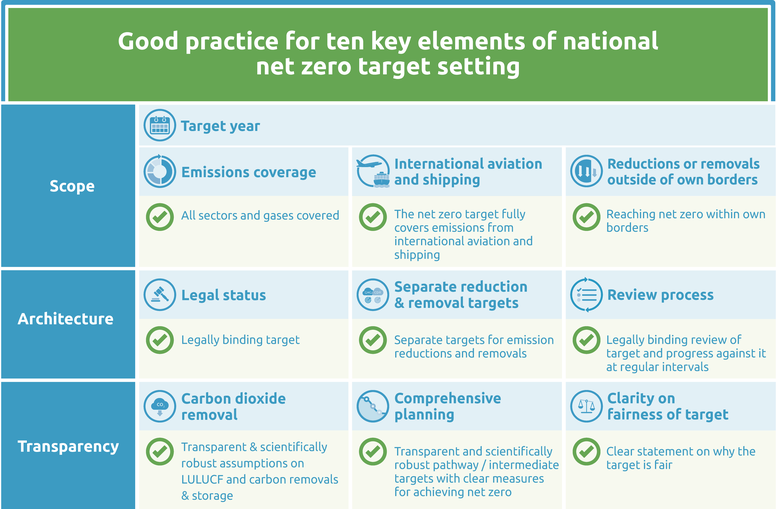Net zero targets
Summary
We evaluate the target as: Poor
In 2021 Türkiye announced a 2053 net zero target (Presidency of the Republic of Türkiye, 2021), which was reiterated in Türkiye’s 2053 Long Term Climate Strategy (LTS) released at COP29 (İklim Değişikliği Başkanliği [Climate Change Directorate], 2024).
The LTS lays out how Türkiye intends to reach net zero by 2053. Despite its 2053 net zero target, Türkiye’s LTS reiterates the NDC goal of peaking emissions only by 2038 at the latest. This calls into serious question how Türkiye can achieve net zero just 15 years after peaking its domestic emissions. A net zero pathway requires emissions to start falling as soon as possible – not near the end of the next decade.
The LTS does provide specific emission reductions in some subsectors, for example in the cement, iron and steel, aluminium, and fertiliser subsectors. However, these subsectors are exceptions rather than the norm. The LTS generally lacks clear emissions reduction targets for different sectors, instead leaning towards specific policy targets without showing how these targets, in combination, would place Türkiye on a path to net zero. Indeed, Türkiye does not provide any underlying models which show how it will actually achieve net zero by 2053.
Türkiye’s LTS can be improved by:
- Increasing transparency around the target by providing the underlying pathways which show how net zero can be achieved.
- Introducing a legally binding review of the net zero target to assess progress towards achieving it at regular intervals. Such a review process would benefit from quantified emissions reduction targets for each economic sector, against which progress can be measured.
- Explicitly covering international aviation and shipping in the net zero target. Given Türkiye’s plans to become an international trading hub including plans to construct 31 new ports aiming to advance international maritime freight transportation, this is all the more relevant (İklim Değişikliği Başkanliği [Climate Change Directorate], 2024).
Türkiye has a draft version of its climate law, "İklim Kanunu”, which is intended to help meet the 2053 net zero emissions reduction target (Hürriyet Daily News, 2022; Republic of Türkiye Ministry of Environment Urbanisation and Climate Change, 2024b). However, as it is currently formulated, the draft law contains no interim emission reduction targets between now and 2053 (Republic of Türkiye Ministry of Environment Urbanisation and Climate Change, 2024b). This is all the more critical to the credibility of the 2053 target, given that Türkiye’s emissions are expected to rise in the medium term (Government of the Republic of Türkiye, 2023). Many of the holes in the LTS can be filled by including them in the draft climate law, such as providing underlying pathways, introducing legally binding reviews, and explicitly covering international aviation and shipping.
CAT analysis of net zero target
Ten key elements
Scope
- Target year – The LTS confirms Türkiye’s previously stated goal of reaching net zero by 2053.
- Emissions coverage – We assume that Türkiye’s LTS covers all greenhouse gas emissions because the LTS generally mentions that all greenhouse gas emissions are included in its national greenhouse gas inventory, but it does not explicitly state that they are covered as part of its net zero target. All economic sectors (excl. international bunkers) are covered by the net zero target. Given that all GHGs and sectors are referred to in the LTS, we have upgraded the rating from red to green.
- International aviation and shipping – The LTS provides no further information on whether the net zero target covers international bunkers.
Under Türkiye’s Emissions Trading System, international shipping will be included, though international aviation will not (Aşıcı, 2024; Safety4Sea, 2024). - Reductions or removals outside of own borders – Türkiye intends to consider using international carbon markets to achieve its net zero target and plans to establish a national carbon crediting system.
Target architecture
- Legal status – The LTS has been submitted to the UNFCCC, but the Climate Law to enshrine the target into law has not yet been passed as of February 2025.
- Separate reduction & removal targets – The LTS does not provide separate emission reduction and removal targets.
- Review process – Türkiye’s LTS provides no information on its intention to establish a review cycle for its net zero target.
Transparency
- Carbon dioxide removal – Türkiye does not provide transparent assumptions on carbon dioxide removals, other than stating that it plans to introduce regulations similar to the EU's Carbon Removal Certification.
- Comprehensive planning – Türkiye provides no underlying pathways to demonstrate how it intends to reach net zero, nor are there intermediate sectoral or economy-wide emission reduction targets between now and 2053. The LTS introduces subsector targets for the cement, iron & steel, aluminium, and fertiliser subsectors which provide ministries with important goals to aim for. However, the LTS lacks clear, quantified targets for the main economic sectors which could demonstrate a comprehensive approach to putting Türkiye on a path to net zero by 2053. This lack of comprehensiveness is highlighted by the aim to peak emissions by 2038, which seriously jeopardises any realistic chance of reaching net zero by 2053.
- Clarity on fairness of target – The LTS makes no reference to fairness or equity in the context of its net zero target representing an equitable share of the global mitigation burden.
Good practice
The Climate Action Tracker has defined the following good practice for all ten key elements of net zero targets. Countries can refer to this good practice to design or enhance their net zero targets.
Further analysis
Latest publications
Stay informed
Subscribe to our newsletter







